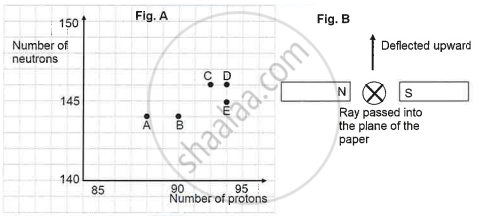Advertisements
Advertisements
प्रश्न
State whether a magnetic field is associated or not around a static charge.
उत्तर
A static charge is not associated with a magnetic field around it.
APPEARS IN
संबंधित प्रश्न
Imagine that you are sitting in a chamber with your back to one wall. An electron beam, moving horizontally from back wall towards the front wall, is deflected by a strong magnetic field to your right side. What is the direction of magnetic field?
State two ways to increase the force on a current-carrying conductor in a magnetic field.
State Fleming's left-hand rule. Explain it with the help of labelled diagrams.
A current flows in a wire running between the S and N poles of a magnet lying horizontally as shown in Figure below:
The force on the wire due to the magnet is directed:

fron N to S
from S to N
vertically downwards
vertically upwards
Two coils A and B of insulated wire are kept close to each other. Coil A is connected to a galvanometer while coil B is connected to a battery through a key. What would happen if:
a current is passed through coil B by plugging the key?
Explain your answer mentioning the name of the phenomenon involved.
State under what conditions force acting on a current carrying conductor which is freely suspended in a magnetic field can be Zero.
When current is parallel to a magnetic field, then force experience by the current-carrying conductor placed in a uniform magnetic field is ____________.
A magnetic field directed in north direction acts on an electron moving in east direction. The magnetic force on the electron will act ____________.
A copper conductor is placed over two stretched copper wires whose ends ate connected to a D.C. supply as shown in the diagram.
- What should be the magnetic poles at the points A and B lying on either side of the conductor to experience the force in the upward direction?
- Name the law used to find these polarities.

|
The graph (fig A) illustrates the correlation between the number of protons (x-axis) and the number of neutrons (y-axis) for elements A, B, C, D, and E in the periodic table. These elements are denoted by the letters rather than their conventional symbols. When the element C, depicted in the graph, undergoes radioactive decay, it releases radioactive rays. When these rays are directed into the plane of the paper in the presence of a magnetic field, as indicated in the fig B, they experience deflection, causing them to move upwards.
|
Name the law used to identify the radioactive radiation emitted by the element.

